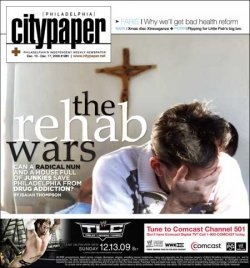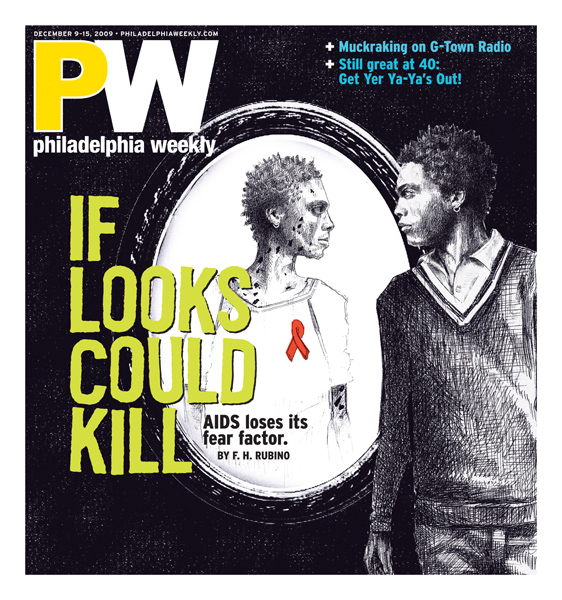 BY DAVE ALLEN Like time, news waits for no man. Keeping up with the funny papers has always been an all-day job, even in the pre-Internets era. These days, however, it’s a two-man job. That’s right, these days you need someone to do your reading for you, or risk falling hopelessly behind and, as a result, increasing your chances of dying lonely and somewhat bitter. That’s why every week PAPERBOY does your alt-weekly reading for you. We pore over those time-consuming cover stories and give you the takeaway, suss out the cover art, warn you off the ink-wasters and steer you towards the gooey center. Why? Because we love you!
BY DAVE ALLEN Like time, news waits for no man. Keeping up with the funny papers has always been an all-day job, even in the pre-Internets era. These days, however, it’s a two-man job. That’s right, these days you need someone to do your reading for you, or risk falling hopelessly behind and, as a result, increasing your chances of dying lonely and somewhat bitter. That’s why every week PAPERBOY does your alt-weekly reading for you. We pore over those time-consuming cover stories and give you the takeaway, suss out the cover art, warn you off the ink-wasters and steer you towards the gooey center. Why? Because we love you!
ON THE COVER
CP: You’ve no doubt seen the t-shirt, or bumper sticker: Rehab is for quitters. It’s a hard-hearted sentiment wrapped around a laugh, but it’s just the approach that a hardcore nun with a tough-love bent in North Philly is taking. New Jerusalem Now is rehab for people who just can’t stay clean; indeed, rehab for quitters. Isaiah Thompson dives into this venture of what Sister Margaret McKenna calls “desert spirituality.”
New Jerusalem’s rules center first and foremost around maintaining sobriety. Before being granted an  admission interview, newcomers must spend a week as “guests.” They do no chores, and take on no responsibilities. “They live like a king for seven days,” says Robert Hardwick, who manages the entry-level men’s house. But they are also monitored constantly, and can leave only with an escort. And, of course, they have to stay clean. A significant number of newcomers don’t finish the first week.
admission interview, newcomers must spend a week as “guests.” They do no chores, and take on no responsibilities. “They live like a king for seven days,” says Robert Hardwick, who manages the entry-level men’s house. But they are also monitored constantly, and can leave only with an escort. And, of course, they have to stay clean. A significant number of newcomers don’t finish the first week.
Once voted into the house, guests enter a “blackout” period of 60 days, during which their activities remain strictly controlled. They may not use the phone or go anywhere unescorted. Meanwhile, they take on a litany of chores and duties — cooking, cleaning, attending meetings and performing community service. Every Friday, New Jerusalem residents turn the house parking lot into a makeshift food pantry, distributing donated bread and produce to neighborhood residents in need. The line for food goes around the block. As McKenna sees it, service is integral to recovery.
“Getting involved helps them change their vision of themselves,” she says. “They have a vision of themselves as being harmful to others. … It seems to me [that community service] quickens something in them. ‘Oh, I can be a good person, I can do good things, I can help people.’ It’s very natural, it seems to me, for addicts to want to be helpful people.”
Naturally, not everyone sees a house full of recovering addicts as an asset to the community, and Thompson capably navigates the web of interference and resistance that city government and neighborhood organizations have put forth against New Jerusalem and other recovery houses. Its value to the community, though, can be seen in reduced relapse rates that compare favorably with inpatient treatment. And Sister Margaret is accomplishing this in the heart of North Philly, where the possibility of going back to drugs waits on nearly every corner. Bravo to the Sister and to Thompson, and good luck to the clients at NJ.
PW: In exploring the present state of HIV/AIDS sufferers in the city, F.H. Rubino hones in on R. Vincent Johns, a recently-infected 28-year-old who admits to bed-hopping but also used protection… with everyone except the guy who gave him AIDS. It might seem irresponsible, even disturbing, but evidently it’s a common phenomenon:
 …more than a few voices in the AIDS services community caution that in the decade-plus since effective antiretroviral meds have transformed HIV infection from a disfiguring, uncompromising death sentence into a chronic but manageable infection, too many people have lost their fear of getting the virus.
…more than a few voices in the AIDS services community caution that in the decade-plus since effective antiretroviral meds have transformed HIV infection from a disfiguring, uncompromising death sentence into a chronic but manageable infection, too many people have lost their fear of getting the virus.
“I’ve absolutely had people tell me they let their guards down, maybe took chances because AIDS is now a treatable disease,” says Kevin Burns, executive director of 12th and Arch-based ActionAIDS, the largest AIDS service organization in Pennsylvania. “Some people kind of have the attitude that, you know, ‘If I get it, I’ll just have to take a pill.’”
Ron Powers, director of programs for the Mazzoni Center, which characterizes itself as the city’s LGBT (lesbian, gay, bisexual, transgendered) health center, adds, “I don’t think most people actually say it that clearly, but it’s more in terms of they didn’t think of it as such a big deal anymore. I think there’s some complacency in terms of people looking at it like all you need to do is take a couple of pills a day and you’ll be fine.” The problem with that outlook—even as quarter-century-old images of deathly sick gay men covered in purplish Kaposi’s sarcoma (KS) lesions tottering into big-city emergency rooms fade—is that HIV/AIDS is still an epidemic to be feared.
Rubino’s account is well-sourced in breaking down the racial divide among those with AIDS and tracking the changes in demographics: men who have sex with other men (MSM) once were the largest segment of sufferers, then IV drug users, and now heterosexuals. Other accounts, from Dawna Edwards and Julio Jackson, fall into the hetero category, and they’re harrowing as well. The tellers of the stories, though, are more than their T-cell count, though.
INSIDE THE BOOK
CP: A crazypants Christmas, musically-speaking. Fish: Sure to inspire more jam-band-themed eateries. I thought this city loved an underdog — you deserved better, Brett. Gay Santa at Giovanni’s Room: Will he lead a rousing chorus of “Silver Bears”?
PW: With apologies to George Orwell: two wheels good, four wheels bad. Join the Club: “Ed Feldman exists to piss people off.” If you like it, then you should have put foie gras on it. Reaching back to the Stones in ’69: Who needs a “best of the decade” list?
WINNER: Isaiah Thompson, fresh off his “General Excellence in Writing for a City Publication” win, doesn’t need another accolade. But I’ll give him one anyway. With its excellent, in-depth cover story, CP takes it.
